Sprinkler irrigation looks simple on the surface. Hook up a pipe, screw on a head, flip the switch. Water rains down, everything gets a drink. Done, right?
Well… sometimes. But also, no.
Because it turns out, there's a pretty big gap between just getting water on plants and doing it well. Like, without wasting half of it to wind, uneven pressure, or just poor timing.
Sprinkler systems can be smart and efficient – if you know how, when, and where to use them.
In this article, I'll walk you through everything that matters. The right systems. The right timing. The right layout for your land. All without drowning your crops (or your patience).
What Is Sprinkler Irrigation (and Why Use It)
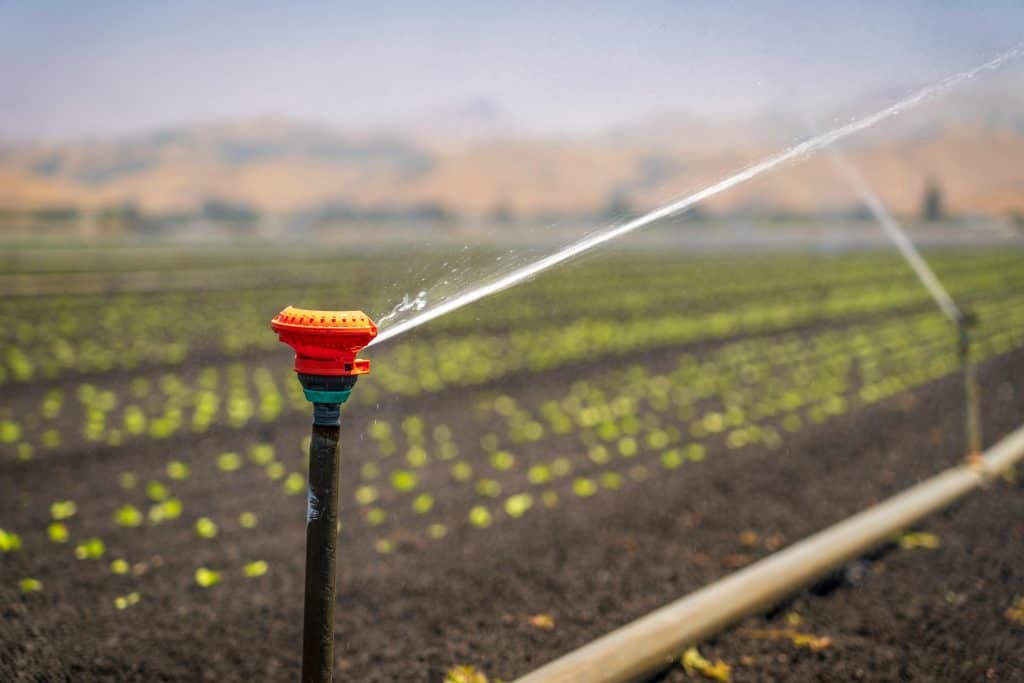
Sprinkler irrigation is exactly what it sounds like: controlled rainfall on demand.
You’ve got a pressurized system that pushes water through pipes and out through sprinklers, spraying droplets across your field, lawn, or garden. It mimics natural rain – but with a little more control (or, ideally, a lot more).
Now, why use it?
First, flexibility.
Sprinklers can cover just about any terrain – flat fields, gentle slopes, weird-shaped gardens. If the land’s usable, odds are you can irrigate it with the right setup.
This is especially useful for uneven or undulating land where flood irrigation doesn’t even stand a chance.
Second, soil compatibility.
While sprinkler systems work best on sandy soils (since water soaks in quickly), they can be used with almost any type – as long as you adjust the droplet size and output rate.
Just don't try to blast hard clay with a high-pressure raingun. You’ll end up with puddles, runoff, and possibly compacted soil.
Third (and this part doesn’t get mentioned enough) sprinklers save land.
There’s no need for ditches, bunds, or channels that take up space and need maintenance. Everything’s in pipes, usually above ground or buried.
That means more room to plant, less work digging and leveling.
Also: no conveyance loss.
Water doesn’t seep away in a long ditch before it gets to the plants. It goes straight from your pump to the nozzles and lands where you want it (unless the wind gets involved, but we’ll get into that later).
And then there’s versatility. Sprinklers aren’t just for watering – they can:
- Apply liquid fertilizer or chemicals evenly across crops
- Cool down heat-stressed plants in the middle of a dry spell
- Save tender buds from frost damage with a light, steady mist
It’s not perfect. But when you use it right – sprinkler irrigation is way more than just spraying water around.
Where Sprinkler Irrigation Works Best
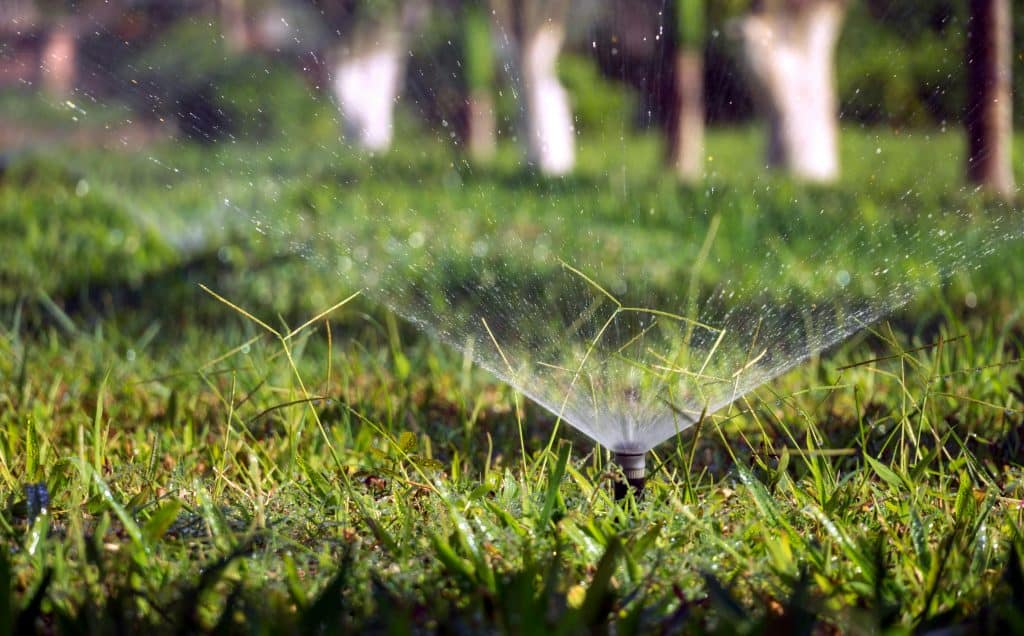
Sprinkler systems aren’t picky about shape. That’s one of their biggest perks.
Got a square field? No problem. Long and narrow? Still fine. Weird wedge-shaped patch on a hill? Surprisingly, yes – that too.
As long as you’ve got a water source and a pump with enough pressure, you can likely make it work. But some situations definitely stand out as especially sprinkler-friendly.
Sloped or Uneven Terrain
Unlike surface irrigation (which needs a relatively flat and uniform layout), sprinklers don’t rely on gravity. That means they’re a solid option for rolling hills or terraced farms.
To avoid pressure drops and uneven spray, you’ll want to run the lateral pipes along the contours of the slope, not up and down.
That simple change can make a massive difference in how evenly your crops get watered.
Sandy Soils
Sprinklers pair well with sandy soils – mainly because they can deliver frequent, low-volume watering that matches the soil’s fast infiltration rate.
The water soaks in instead of running off, and plants get just enough without drowning.
Orchards and High-Value Crops
Here’s where things get a little more interesting. Sprinklers are often used in places where water isn't just about hydration – but also protection.
In orchards or salad greens, for example, a sprinkler system can:
- Cool plants during extreme heat (which helps avoid crop stress or sunburn)
- Prevent frost damage by forming a protective layer of ice that shields sensitive buds
Yeah, it sounds backwards – spraying water to fight frost – but it actually works.
The slow release of heat during ice formation keeps plant tissue just above freezing. It’s weird science, but it’s been saving crops for decades.
Fields Without Room for Channels
No space for trenches or irrigation ditches? Sprinklers don’t care. There’s no need to carve up your planting area – everything’s piped.
That means more room to grow, and fewer spots for weeds to thrive or water to stagnate.
Bottom line: if your land has a slope, your soil drains fast, or you’re growing something sensitive to heat or cold – sprinklers are a solid match.
When to Use Sprinkler Irrigation
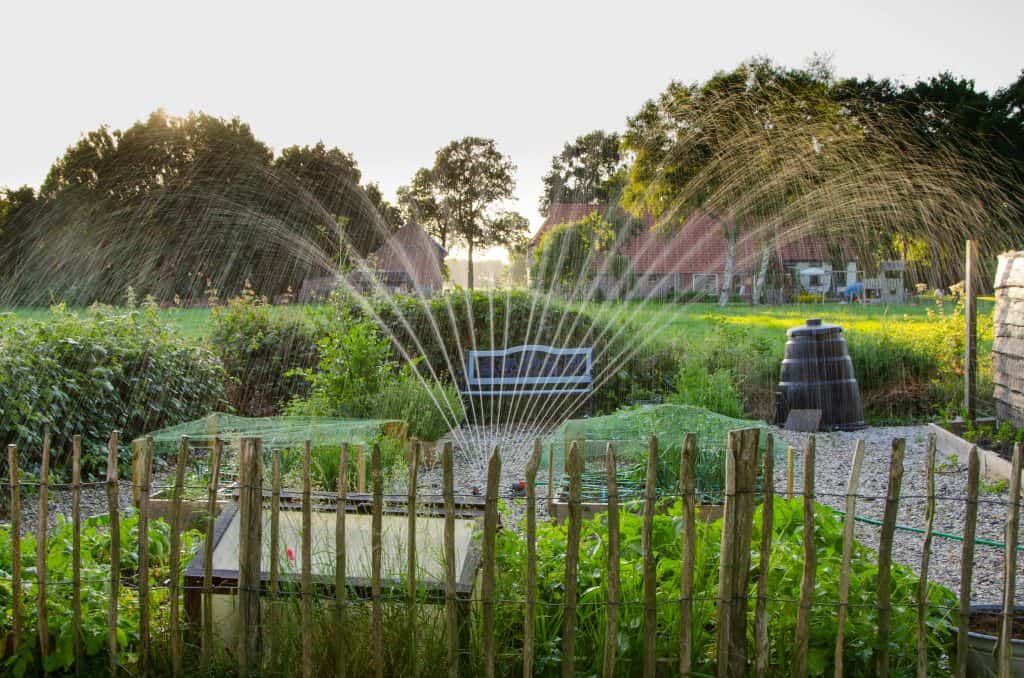
Sprinkler systems don’t run on a strict schedule – they run best when they respond to what the weather and the soil are doing. But there are some solid rules of thumb for getting the timing right.
Best Time of Day
Early morning. Every time.
Running sprinklers in the middle of the day wastes water – a lot of it. The sun pulls moisture off leaves and out of the soil before it can soak in.
Afternoon watering might look fine, but you’re basically feeding the air.
Evening watering? That’s worse. Water sits on leaves overnight, raising humidity and inviting fungal diseases (blight, mildew, the usual suspects). So unless you’re fighting off a late frost, avoid night runs.
Seasonal Use
Sprinklers come into their own during the hot, dry months. When the sun’s baking the soil and plants are sucking up every drop, you need a system that can deliver consistent coverage fast – especially over large areas.
But that’s not the only time they shine. On chilly spring nights, a light mist can save your fruit trees from frost.
It’s one of those tricks that sounds made up until you see it work – ice forming over buds, actually protecting them from colder air. Strange but true.
And during heatwaves, running a sprinkler system for a few minutes can help cool delicate crops, like lettuce or spinach, that bolt or wilt under stress.
Not drenching – just a brief misting to drop the temperature.
Crop Stage and Soil Moisture
When plants are young or newly transplanted, they need regular moisture – and the root systems are still shallow.
Sprinklers are great here, especially if you’ve got micro-sprinklers or a system that can dial down the droplet size.
Once crops mature and roots go deeper, you can back off a bit – or switch to systems that water less frequently but more deeply.
Also, if your soil’s still moist from rain? Don’t water. Obvious, but a lot of automated systems waste gallons this way. If you're not using sensors, check the soil by hand.
So when’s the right time to use a sprinkler system?
- Morning, not evening
- During dry spells, heatwaves, or frost risks
- When plants are young, shallow-rooted, or heat-sensitive
- When you’ve checked the soil and it actually needs water
How to Use Sprinkler Irrigation Effectively
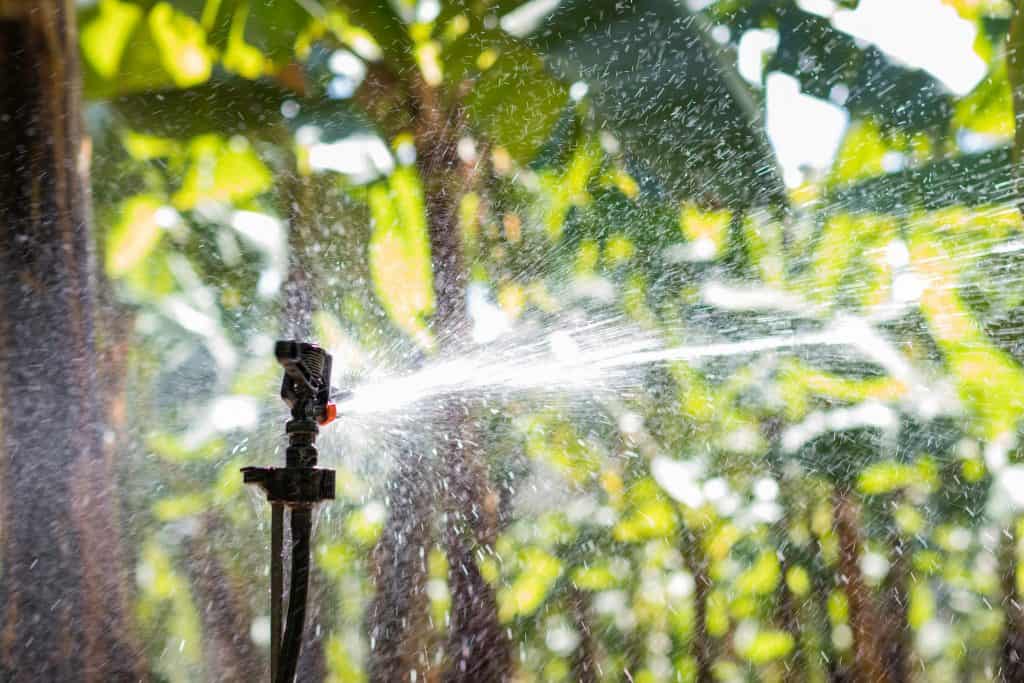
You can have the best pump, the flashiest nozzles, and still water your crops unevenly if your setup’s off.
Getting sprinkler irrigation right is more than just spraying water. It’s about pressure, spacing, and not flooding your field or blowing droplets into the neighbor’s yard.
Sprinkler Spacing: The Overlap Rule
Sprinklers don’t cover perfectly round areas. There are gaps unless you plan for them.
To get even coverage, aim for at least 65% overlap between the wetted areas of each sprinkler.
That sounds like a lot, but wind, pressure drops, and even spray pattern shape can leave dry patches without it.
Think of each sprinkler’s coverage like a coin tossed onto the ground. You want the next one to land partly over the first one. Repeat that across your field and suddenly everything’s watered evenly.
Follow the Land’s Contour
This one matters most on sloped or uneven land: lay your laterals along the contour.
Why? Because going up and down hills causes pressure changes. Sprinklers at the top don’t spray enough, the ones at the bottom flood.
Running the pipes across the slope evens out the pressure and gives you better distribution.
Pressure Is Everything
Each sprinkler head is designed to run at a specific pressure.
Too low? The water jet doesn’t break up – it just shoots out in a sad arc and drops everything at the edge. Too high? You get mist. A fine cloud that looks nice and goes absolutely nowhere useful. It's a balancing act.
Most pressure issues come from:
- Worn-out pumps
- Long, narrow pipes with too much friction loss
- Sprinkler heads that are just too far from the source
Solution? Keep pipes short where possible, maintain your pump, and don’t mix high- and low-pressure heads on the same line.
Start the Right Way
If you're using a portable setup:
- Lay pipes starting from the pump, not the far edge. That ensures connections line up properly and pressure is balanced.
- Keep couplers and seals clean. A bit of grit in the groove? That’s a slow leak waiting to happen.
- Open the delivery valve slowly after the pump builds pressure. Slamming it open too fast can jolt the system and pop connections.
Don't Fight the Wind
Even a gentle breeze will mess with spray patterns. Water that should land two feet away ends up ten feet off.
If it’s a windy day, shorten the distance between sprinklers. You’ll waste less, water more evenly, and avoid soaking the fence line.
Types of Sprinkler Systems and Where to Use Each One
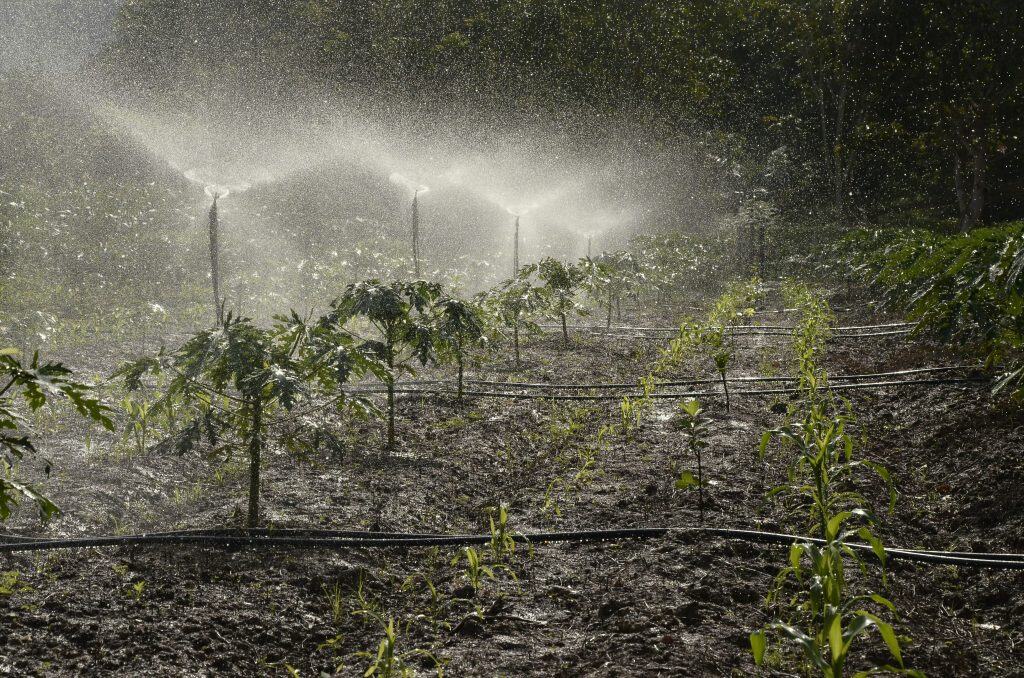
Not all sprinkler systems are created equal. Some need more labor, others cost more upfront but save you time. Some are great for row crops, others for lawns or tree orchards.
Choosing the right type isn't about what’s newest – it’s about what actually fits your land, crop, and how much work you're willing to put in.
1. Hand-Moved Systems
Simple. Manual. Labor-heavy.
You’ve got lightweight aluminum or PVC pipes, and you move them around the field – sometimes four times a day.
These are cheap to set up but high maintenance in terms of effort. Good for small plots or if you’ve got low-cost labor on hand. Not ideal for large acreage or if you want to sleep in.
2. Drag-Hose Systems
Buried pipes, with sprinklers on skids connected by hoses.
You only move the sprinkler on the skid, not the pipe. It’s an upgrade from hand-moved – less labor, more efficient especially if you're dealing with permanent crops like orchard rows. Still manual, but easier.
3. Hose Reel Raingun (Traveling Gun)
A big sprinkler mounted on a cart, connected to a hose that rewinds as it sprays.
Good for large fields and farms that don’t want to set up a ton of infrastructure. These are semi-automated, and one person can usually manage it. Not great on very hilly or broken terrain.
4. Center Pivot Systems
The big ones you see in aerial farm photos – huge arms rotating around a fixed point.
Great for large, flat fields. One machine waters everything in a big circle. Super low labor, highly efficient over big acreage. Downside? Circular fields mean some corners stay dry unless you use additional setups.
5. Linear Move Systems
Like a center pivot, but it moves in a straight line instead of rotating.
Perfect for rectangular fields which most farms actually are. Efficient, needs decent infrastructure and planning. Less common than pivots but just as effective if you've got the right shape.
6. Fixed Set & Permanent Set
Sprinklers mounted on risers, either above ground or with buried piping.
These are best for perennial crops like orchards, vineyards, or high-value salad greens. Once installed, they stay put. Higher upfront cost, but low maintenance and consistent performance.
7. Micro-Sprinklers
Low-pressure, small-radius heads – kind of a halfway point between drip irrigation kits and standard sprinklers.
They’re great for tree crops, greenhouses, and gardens. Gentle on the soil, targeted, and very water-efficient. They don’t throw water as far, but they don’t need to.
8. Fixed Head Sprinklers (for Lawns & Small Gardens)
No rotation, just a steady spray. They use more water per square foot but require lower pressure.
Perfect for sandy soil that can take a lot of water fast — or for areas where uniform coverage matters more than distance.
So, what system fits best?
- Small garden? Fixed heads or micro-sprinklers.
- Big farm? Center pivot or hose reel.
- Orchard? Drag-hose or fixed set.
- Weird-shaped field? Hand-moved or micro-sprinklers can adapt easily.
There’s no one-size-fits-all. But once you know what you're working with, there’s always a setup that fits.
Maintenance and Common Issues
Sprinkler systems are one of those things that work great – until they don’t. A clogged nozzle, a leaking coupler, a sprinkler head that refuses to turn. Suddenly you’re hand-watering in 90-degree heat and swearing under your breath.
The good news is most of the problems are predictable – and fixable.
Leaky Couplers and Fittings
If you're seeing water spraying from places it shouldn't, start here:
- Check for dirt or sand in the groove where the rubber sealing ring fits. Even a tiny bit of grit can wreck the seal.
- Make sure the pipe ends are smooth and clean before coupling them.
- Sealing rings are designed to drain water when pressure drops – that’s normal. But if they leak under pressure, it’s a seal issue, not a design flaw.
Sprinkler Head Not Turning
Classic problem. Usually one of three causes:
- Low pressure – the head needs more juice to rotate properly.
- Clogged nozzle – clear it using a soft wood stick (never metal).
- Sticky swing arm – make sure it’s not bent or jammed, and check the tension in the spring. If it’s too loose, rebend it to tighten it up.
Don’t oil or grease the head. They’re water-lubricated. Grease just gums things up.
Worn Washers
If your system runs on sandy water, expect the washer at the base of the sprinkler bearing to wear out faster than anything else.
These are cheap and easy to replace – and doing so saves your more expensive metal parts from grinding down.
Pressure Fluctuations
Over time, pumps wear out and friction builds up in aging pipes. That can cause pressure drops, especially at the ends of long lines. You’ll start seeing uneven spray – one side floods, the other barely drips.
Keep an eye on:
- Pump performance (output vs. rated pressure)
- Friction losses in older or thinner pipes
- Clogged filters or lines
A regular flush of the system (uncapping and running water through) helps clear out buildup before it turns into a full blockage.
Startup and Shutdown
Start with valves closed. Let the pump build pressure. Then open the delivery valve slowly to avoid a pressure surge.
When shutting down, close the valve before cutting power to the pump. This prevents backflow or sudden pressure drops that can pop fittings.
These systems aren't fragile. But they do need occasional attention especially before planting season or after they’ve sat idle for a while.
Catch small problems early, and you won’t spend your summer tracking leaks across the field.
Storage and Off-Season Prep
The season ends. You shut off the pump. But if you just walk away and leave everything in the field – don’t be surprised when next spring starts with cracked fittings, stiff pipes, and a sprinkler head that’s now home to a spider colony.
Proper storage isn’t complicated. But it makes a big difference.
Remove the Sprinklers
Take them off and clean them up. Even if they look fine, mineral buildup or dirt inside can harden over winter. Give them a rinse, let them dry, and store them indoors in a cool, dry place.
No, not the shed with the leaky roof. A real dry place.
Take Out the Rubber Seals
Those little rings in your couplers and fittings? Don’t leave them in. Rubber breaks down in sunlight, heat, and moisture.
Remove them and store them somewhere dark and cool like a drawer in the garage or a labeled zip bag in the basement.
Storing Pipes
PVC or aluminum pipes can handle being outside, but give them a little help:
- Store them on a rack or surface with one end slightly elevated so water drains out.
- Don’t pile them on damp concrete, next to fertilizer bags, or in weedy grass. That’s how corrosion, staining, and pest problems start.
Fertilizer and Pipe Storage Do Not Mix
Sounds minor, but it matters – never store fertilizer sacks on or near your pipes. The dust and fumes can degrade plastic and metal faster than you’d think.
Also: never lay pipes on fresh concrete. Chemical reaction = pipe damage.
Pump and Motor Care
- Disconnect suction and delivery pipes.
- Pour in a little medium-grade oil to coat the pump interior.
- Give the shaft a few turns, then cap off the inlet and outlet.
- Grease the shaft and bearings.
- For electric motors: keep them dry and rodent-proof. Throw a tarp over them, seal openings, and store off the ground if possible.
Off-season prep doesn’t take long. But skipping it means you’re just buying time until your next breakdown. A few simple steps now can save you hours (and a bunch of money) when the season kicks back in.
Bonus Uses of Sprinkler Systems
Sprinklers aren’t just about keeping plants alive. They’ve got a few surprise tricks and when used right, they can protect crops, boost yields, and even save an entire harvest from going sideways.
Frost Protection
This one feels like a magic trick – using water to keep plants from freezing. But it’s real.
During a sudden spring frost, a slow, steady spray can form a thin layer of ice on buds or blossoms.
As the water freezes, it releases a tiny amount of heat (latent heat, if we’re getting technical), keeping the plant tissue at or just above freezing.
It's weird. It works. And for fruit growers, it can be the difference between a full harvest and a total loss.
Crop Cooling
Hot weather hits some crops harder than others. Leafy greens like lettuce, spinach, or cilantro? They’ll bolt or wilt fast if temperatures soar.
A quick midday misting from overhead sprinklers can drop canopy temperatures and keep plants from stressing out. You’re not soaking the soil here – just cooling the air and the leaves.
Fertigation and Chemigation
If you’ve ever lugged a tank of fertilizer around a field, you’ll appreciate this.
Sprinkler systems can be fitted with fertilizer or chemical injectors (like a venturi injector) so you can deliver nutrients or treatments straight through the water line.
This lets you hit wide areas evenly without extra labor or equipment. It's precise, time-saving, and great for big fields.
Just make sure the system’s designed for it – not all sprinklers handle chemicals well, and you don’t want to backflow that mix into your water source.
Dust Suppression
Rarely talked about, but handy: sprinklers can help keep dust down around field edges, paths, or processing areas.
Useful in dry, windy climates where dust can stress crops or clog filters and machinery.
Sprinklers are more than a way to get water from point A to point B. When you know how to use them right, they’re tools for protection, efficiency, and sometimes damage control.
Pick the right sprinkler setup for your land and let it work for you.
Sprinkler irrigation isn’t one system – it’s a whole toolbox.
You’ve got options for flat land, slopes, small gardens, massive fields. You can go low-budget and manual, or fully automated with sensors and software.
It all depends on your crop, your soil, and how much time you’ve got to manage it.
Used right, sprinkler systems do more than water plants. They save space. Deliver fertilizer. Protect against frost. Cool heat-stressed crops.
But to get those benefits, you’ve got to plan for pressure, spacing, soil type – and yeah, wind. Always the wind.
Not every field needs sprinklers. But when they’re the right fit? They do a lot more than most people think.
Frequently Asked Questions (FAQs)
1. What’s the best time of day to run a sprinkler system?
Early morning. It reduces evaporation and wind drift, and gives plants time to dry before nightfall – which helps prevent disease.
2. Can I use sprinkler irrigation on hilly or uneven land?
Yes – just make sure to lay your lateral pipes along the contour of the slope. This helps maintain even pressure and avoids runoff at the bottom.
3. Which system is easiest to maintain with low labor?
Center pivot and hose reel systems are the most hands-off once installed. Drag-hose is a decent middle ground. Hand-moved systems are the most labor-intensive.
4. How can I reduce water waste with a sprinkler setup?
Use low-flow nozzles, water early in the day, avoid windy conditions, and match your application rate to the soil’s infiltration rate. Moisture sensors help too.
5. What crops benefit most from sprinkler irrigation?
Leafy greens, grains, orchards (especially when using micro-sprinklers), and any crop grown on sandy or well-draining soil. Just avoid crops prone to foliar diseases if you’re watering frequently.
Ready To Transform Your Garden?
Are you looking for the best way to layout your garden beds? Maybe you're feeling a bit stuck on how to make the most of your space?
We’ve got you covered! Check out our 101+ Garden Bed Layout Ideas for your next raised bed project. This guide is filled with creative and practical ideas that can help you design a garden that fits your style, whether you’re just starting out or have been gardening for years.
Get your copy today and get inspired to bring your gardening dreams to life.

